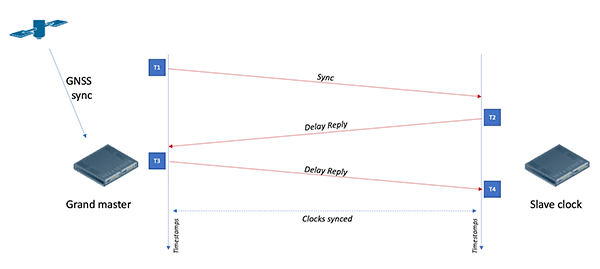5G networks are heavily reliant on highly accurate phase and time being available to deliver on the promise of 5G-NR.
Two technologies have historically been used to deliver synchronisation to base stations, PTP and Synchronous Ethernet, however, the technology and capabilities of each are very different.
Synchronous Ethernet
Synchronous Ethernet uses a traditional synchronisation delivery method that has been used previously in transmission networks going back to the SDH and PDH networks.
In this case, the synchronisation is derived from the edges of the pulses being sent across the transmission medium (copy or fibre optic cables).
A high-quality clock reference – derived perhaps from a GPS clock source or a caesium clock – is used to time the output from the core of the network. In this way pulses sent down the fibre or cable occur at a frequency that matches the clock reference.

Transmitted signal edges are times to match the frequency of the sync source. Clock recovery at the far end extracts sync and uses it for internal timing as well as a possible external option.
At the far end of the link, a clock recovery operation occurs, analysing where those signal edges are and using this to drive another clock within the receiving equipment. In this way, the receiving equipment can use a similar class of clock reference as that one in the core.
While historically this was carried out over transmission protocols this same technique is now being used over Ethernet links.
A critical function that occurs at the receiving equipment is choosing which of possibly several incoming synchronisation sources should be used, and this is why SyncE uses a messaging protocol – the Ethernet Synchronisation Message Channel (ESMC) – to indicate the synchronisation quality.
The ESMC channel contains a quality level (QL) indicator that tells the receiving device the quality of the synchronisation, and these indicators are compared and used to decide which reference should be used, this is especially important in cases of failover.
There are some limitations. Synchronous Ethernet can only be used to derive a frequency, whereas 5G networks require a source for frequency and phase to deliver maximum bandwidth. Secondly, the timing has to be terminated and regenerated at every piece of equipment down the line. For synchronisation delivery to the edge of the network, every device between the source clock and the edge device needs to be upgraded to support SyncE.
PTP
PTP differs significantly from SyncE in that a protocol (specified in IEEE1588 v2) is used to deliver the timing to the edge of the network. This immediately overcomes the problem in SyncE of requiring every hardware device to be upgraded. In PTP the packets can traverse the network just like any other protocol.
PTP relies on a device called a Grandmaster. This takes a sync source (usually a GPS based source) and uses this source to create a series of timestamped PTP packets that it sends out across the network to slave clocks at the far end.
The slave clocks use the PTP protocol to create a sync signal for use on its local site.
The Slave Clock subscribes to the messages from the Grand Master and from that point on the Grand Master will send Sync packets to the Slave Clock.
The Sync packet that the Grand Master sends includes a timestamp from the time of the packet generation (T1) that is extracted by the Slave Clock, which also stores a timestamp of when it received the packet (T2).
The Slave Clock responds to the sync message by ending a Delay Request packet back to the Grand Master. Within the Delay Request packet, the Slave Clock sends another local timestamp (T3) back to the Grand Master.
When the Grand Master receives the Delay Request packet, it responds to the slave clock with a Delay Response that includes another timestamp (T4) from the Grand Master that is the timestamp for the Delay Request packet being received.

PTP uses a number of timestamps exchanged between the Grand Master and the Slave Clock to deliver synchronisation.
The Slave Clock now has 4 timestamps available from packets exchanged with the Grand Master. These are used to calculate the time offset between the Grandmaster and the Slave Clock.
Once the offset has been calculated, the Slave Clock sets its internal clock to match that of the Grandmaster. The sync output from the Slave Clock is now derived from the same source as the Grandmaster.
The caveat with this method is that the offset calculation assumes that the latency between the Grandmaster and Slave Clock is the same in both directions – and this may not always be the case depending not the state of the network.
Conclusion
Both SyncE and PTP can deliver frequency sync to the edge of the network using completely different methods and with different network requirements and devices.
However, the 5G networks require phase synchronisation to support time division duplex (TDD) radio techniques, so PTP or a combination of PTP and SyncE are required to support these new RAN technologies.
